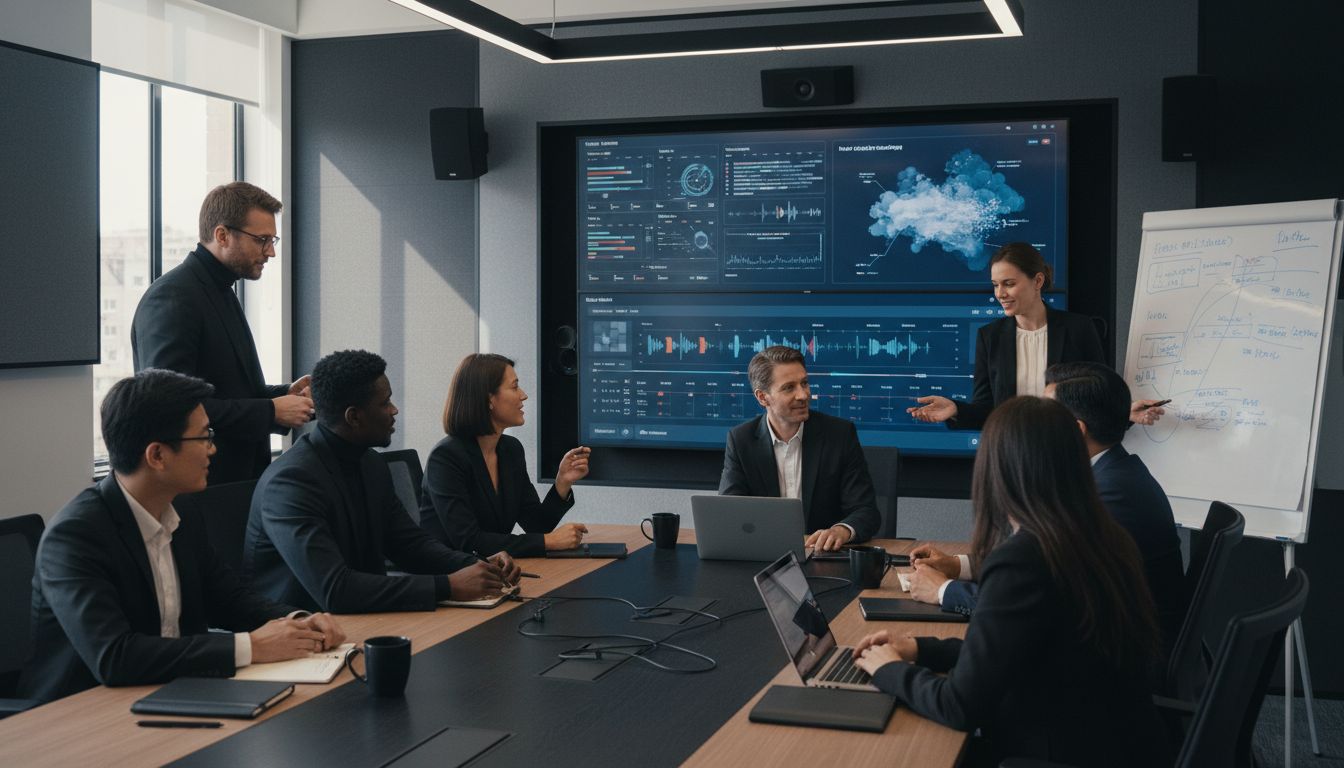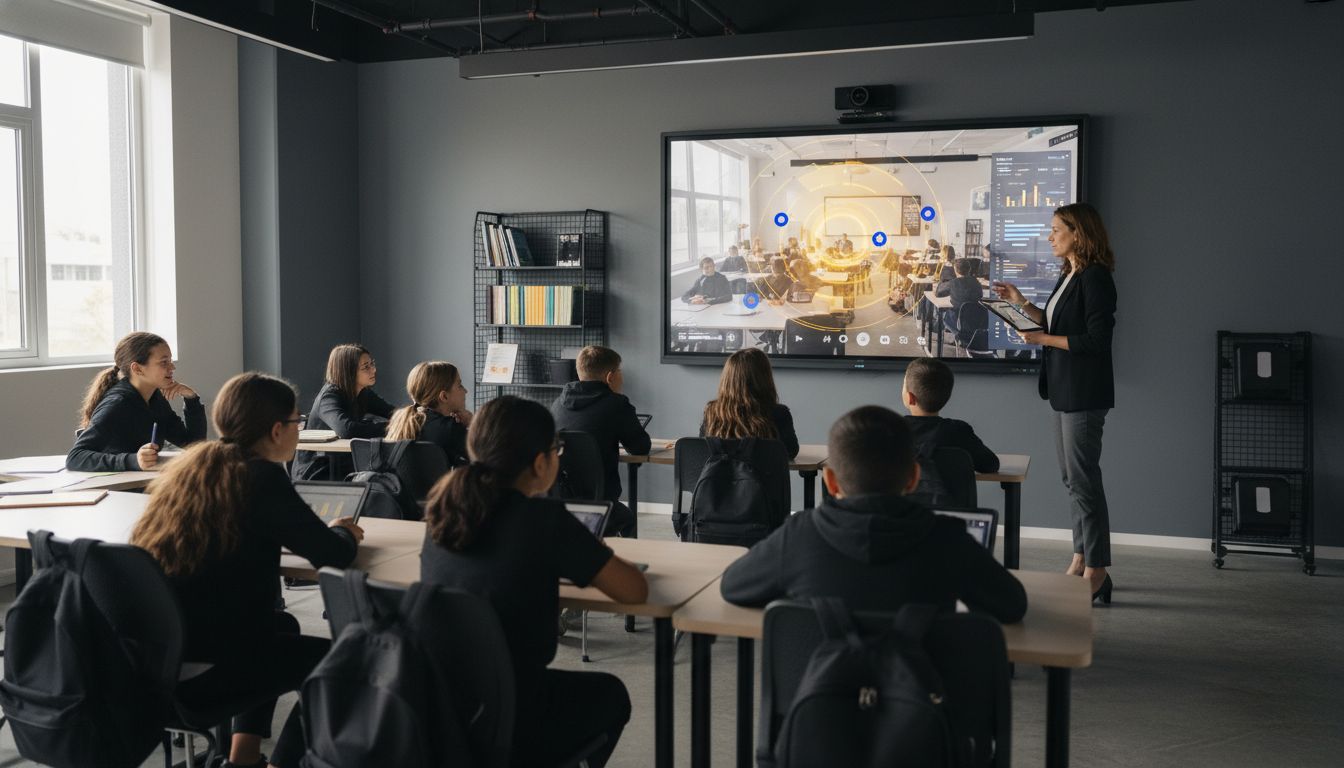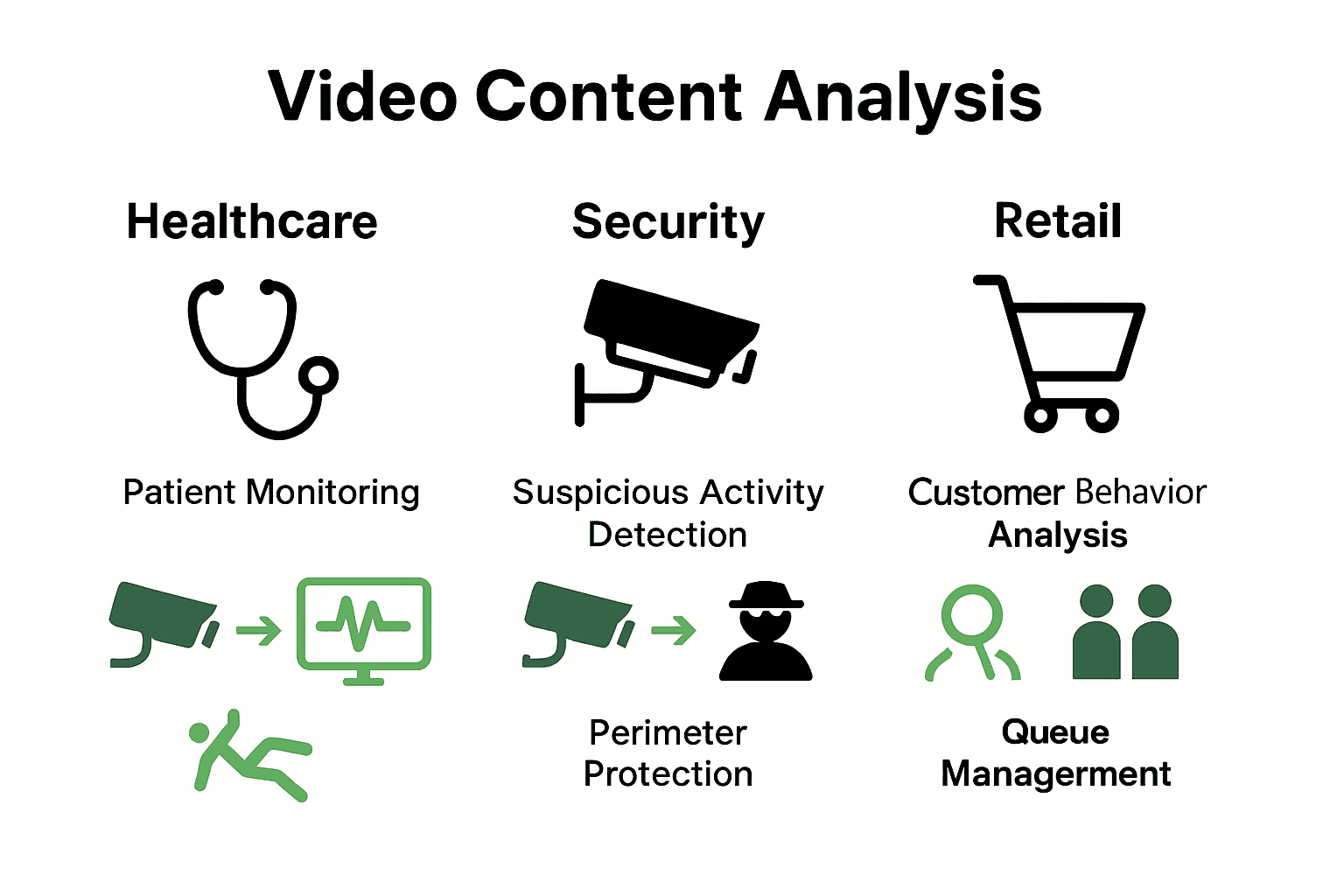Video Content Analysis: Everything You Need to Know

Over half of all data generated online now comes from video content, yet most remains untapped without advanced analysis. As more businesses, educators, and creators rely on video, the need to interpret and organize this rich source of information grows every day. This guide shines a light on the core concepts and breakthroughs powering video content analysis, offering clear explanations that help anyone understand how these powerful tools transform raw footage into real insights.
Table of Contents
- Defining Video Content Analysis And Core Concepts
- Types Of Video Content Analysis Techniques
- How Video Content Analysis Algorithms Work
- Key Applications Across Industries
- Challenges, Limitations, And Future Trends
Key Takeaways
| Point | Details |
|---|---|
| Video Content Analysis | A technology that converts raw video data into actionable insights through advanced computational techniques. |
| Key Techniques | Techniques include temporal action segmentation, signal clustering, and multimodal information extraction. |
| Industry Applications | Applications span healthcare, security, retail, education, and media, unlocking value from multimedia resources. |
| Challenges Ahead | Major challenges include computational complexity, contextual understanding, and privacy concerns that must be addressed to advance the field. |
Defining Video Content Analysis and Core Concepts
Video content analysis represents a sophisticated technological approach to systematically extracting, understanding, and interpreting meaningful insights from multimedia recordings. According to research from arxiv.org, this process involves clustering signals across multiple modalities like audio, video, and text to enhance comprehension of digital media content.
Video content analysis is fundamentally about transforming raw visual data into structured, actionable information. At its core, this discipline employs advanced computational techniques to break down video recordings into granular components that can be examined, measured, and understood. The arxiv.org research highlights critical aspects of this process, including:
- Temporal action segmentation
- Comprehensive signal clustering
- Multimodal information extraction
- Systematic content interpretation
The methodology behind video content analysis typically involves several key stages. First, raw video data is preprocessed and normalized. Then, sophisticated algorithms extract features like motion patterns, audio characteristics, and visual elements. These features are subsequently analyzed using machine learning and computer vision techniques to generate meaningful insights. Whether you’re a researcher, content creator, or business professional, understanding these core principles can dramatically improve how you interact with and derive value from video content.
By leveraging advanced computational methods, video content analysis transforms seemingly unstructured visual information into precise, actionable intelligence. As summyt.app demonstrates, technologies like AI-powered video summarization are making this process more accessible and powerful than ever before, enabling professionals across industries to unlock deeper understanding from multimedia resources.
Types of Video Content Analysis Techniques
Video content analysis encompasses multiple sophisticated techniques designed to extract meaningful insights from multimedia recordings. arxiv.org provides a comprehensive survey that reveals the nuanced approaches used in contemporary video analysis methodologies, particularly highlighting temporal action segmentation as a critical component.
Temporal Action Segmentation represents one of the primary techniques in video content analysis. According to research, this method involves breaking down video sequences into meaningful segments based on actions, movements, and contextual shifts. The key approaches within this technique include:
- Frame Representation: Analyzing individual video frames
- Temporal Modeling: Understanding sequence and progression of actions
- Supervised Learning Techniques: Categorizing video segments with predefined labels
- Unsupervised Learning Methods: Identifying patterns without explicit prior classification
Shot Type Recognition is another sophisticated technique that goes beyond simple temporal segmentation. arxiv.org highlights an innovative learning framework that separates subject and background into distinct streams, enabling more precise classification of visual content. This approach allows for nuanced understanding of visual composition, movement patterns, and contextual transitions within video recordings.
Advanced video content analysis techniques continue to evolve, integrating machine learning, computer vision, and sophisticated algorithmic approaches.

By understanding video summarization techniques, professionals across industries can transform raw visual data into actionable intelligence, unlocking deeper insights from multimedia resources with unprecedented precision and efficiency.
How Video Content Analysis Algorithms Work
Video content analysis algorithms are sophisticated computational processes that transform raw visual data into structured, meaningful insights. arxiv.org highlights an innovative approach that utilizes non-uniform sampling techniques across temporal and spatial domains, enabling more efficient and precise video interpretation.
The core mechanics of these algorithms typically involve several complex stages:
- Input Processing: Capturing and digitizing video frames
- Feature Extraction: Identifying key visual, audio, and contextual elements
- Pattern Recognition: Analyzing movement, object interactions, and sequence transitions
- Machine Learning Classification: Categorizing and interpreting detected patterns
Video Storytelling and Indexing represents a critical algorithmic technique in content analysis. International Journal of Electrical and Computer Engineering demonstrates how advanced algorithms can create comprehensive descriptions and indexes for video content, allowing efficient retrieval and analysis of specific clips from extensive video collections.
Modern video content analysis algorithms leverage cutting-edge technologies like deep learning, neural networks, and advanced AI review techniques to process multimedia information with unprecedented speed and accuracy.
By breaking down complex visual data into digestible, actionable insights, these algorithmic approaches are revolutionizing how we understand, interact with, and extract value from video content across diverse industries and applications.
Key Applications Across Industries
Video content analysis has revolutionized how organizations process and extract value from multimedia resources across diverse sectors. arxiv.org reveals groundbreaking research demonstrating the versatility of multimedia content characterization techniques across multiple industry domains, highlighting the transformative potential of advanced video analysis technologies.
Different industries leverage video content analysis in unique and innovative ways:
- Healthcare: Analyzing medical procedure recordings, tracking patient movements, monitoring surgical techniques
- Security and Surveillance: Detecting suspicious activities, tracking individuals, managing public safety
- Retail: Understanding customer behavior, analyzing foot traffic patterns, optimizing store layouts
- Education: Assessing student engagement, improving learning experiences, monitoring classroom dynamics
- Media and Entertainment: Content recommendation, audience behavior analysis, trend identification
Quality Assessment represents a critical application across professional environments. According to arxiv.org, advanced video analysis models can now evaluate content quality across user-generated, professional, and occupational contexts, ensuring optimized communication experiences. This breakthrough enables organizations to maintain high standards of multimedia content across various platforms and use cases.

Professionals can now transform raw video data into strategic insights by understanding automated video review techniques. These technologies are not just tools but powerful decision-making companions that help organizations extract meaningful patterns, predict trends, and make data-driven decisions across virtually every imaginable industry landscape.
Challenges, Limitations, and Future Trends
Video content analysis technologies continue to evolve, facing complex challenges that push the boundaries of computational capabilities. arxiv.org highlights critical research gaps in current methodologies, particularly in temporal action segmentation, revealing the nuanced limitations that researchers must address to advance the field.
The primary challenges in video content analysis include:
- Computational Complexity: High processing requirements for real-time analysis
- Context Understanding: Difficulty interpreting subtle contextual nuances
- Privacy Concerns: Balancing technological capabilities with ethical data usage
- Multimodal Integration: Seamlessly combining audio, visual, and textual information
- Dynamic Environment Adaptation: Handling rapidly changing visual scenarios
Shot Type Classification presents a particularly intricate challenge. arxiv.org demonstrates that effective video analysis requires more than just content examination, necessitating sophisticated approaches that incorporate spatial composition, camera movement, and contextual understanding. This complexity highlights the need for advanced machine learning models that can interpret visual information with human-like nuance.
Looking forward, the future of video content analysis will likely be shaped by emerging technologies like deep learning, neural networks, and advanced AI review techniques. Researchers are developing increasingly sophisticated algorithms that can understand context, predict trends, and extract meaningful insights with unprecedented accuracy, promising a future where video analysis becomes an indispensable tool for understanding complex multimedia landscapes.
Unlock the Power of Video Content Analysis with SummYT
The article highlights the complexity of understanding video content through techniques like temporal action segmentation and multimodal information extraction. Many struggle with the challenge of efficiently decoding vast video information without losing valuable insights or wasting time on lengthy content. If extracting key takeaways while bypassing irrelevant details is your goal, SummYT’s AI-powered capabilities provide the perfect solution to this problem.

Discover how easy it is to transform overwhelming video content into clear, concise summaries with SummYT’s cutting-edge YouTube summarizer. Designed for professionals, students, and lifelong learners, SummYT helps you save hours by generating instant actionable insights and removing fluff or distractions. Stop letting hours slip away in front of your screen. Visit https://summyt.app now and experience faster, smarter video learning and review based on advanced video content analysis principles.
Frequently Asked Questions
What is video content analysis?
Video content analysis is a technological method used to extract, understand, and interpret insights from video recordings by transforming raw visual data into structured information through advanced computational techniques.
What are the main techniques used in video content analysis?
Key techniques include temporal action segmentation, shot type recognition, feature extraction, and machine learning classification, which help analyze and categorize video content effectively.
How do video content analysis algorithms work?
These algorithms function by processing video input, extracting features, recognizing patterns, and classifying content through machine learning approaches to generate meaningful insights from multimedia data.
What are the applications of video content analysis across various industries?
Video content analysis is used in healthcare, security, retail, education, and media to track activities, analyze behavior, assess quality, and improve overall decision-making based on visual data.



